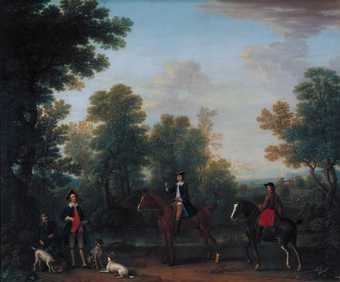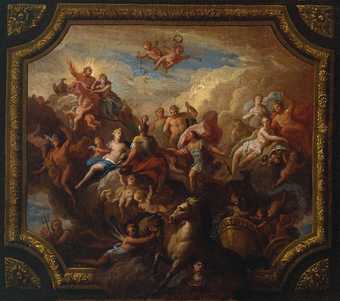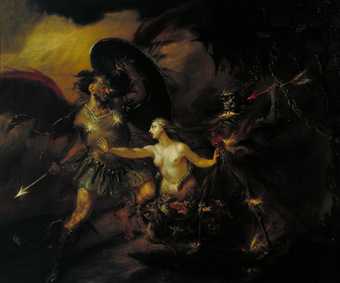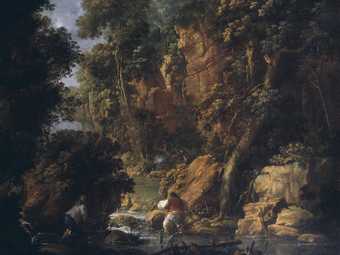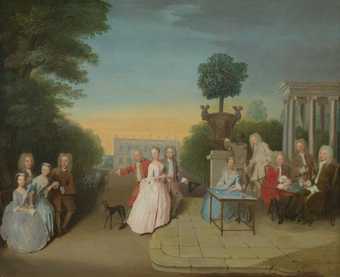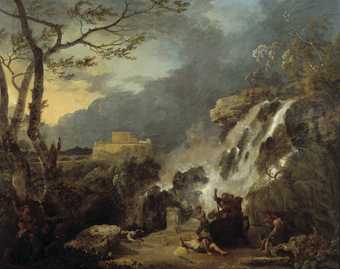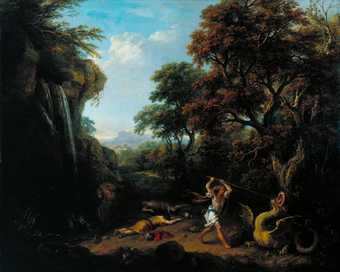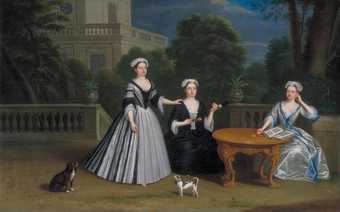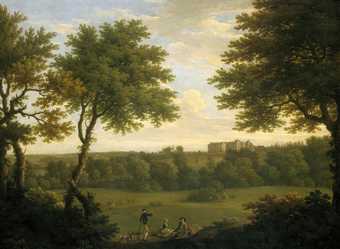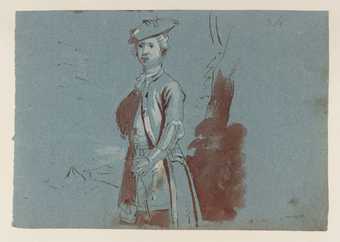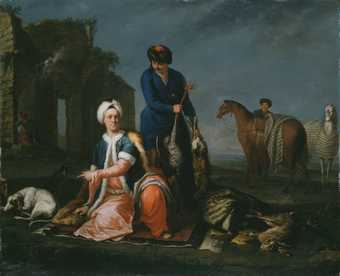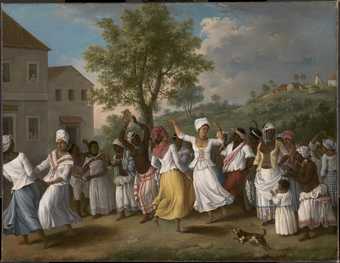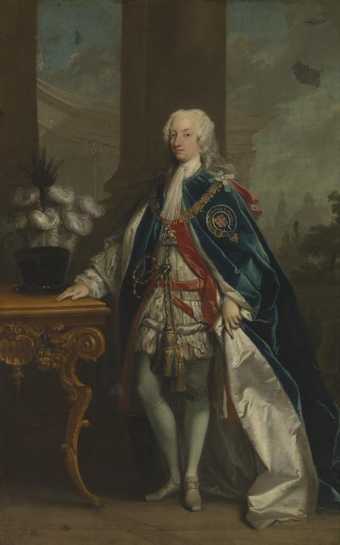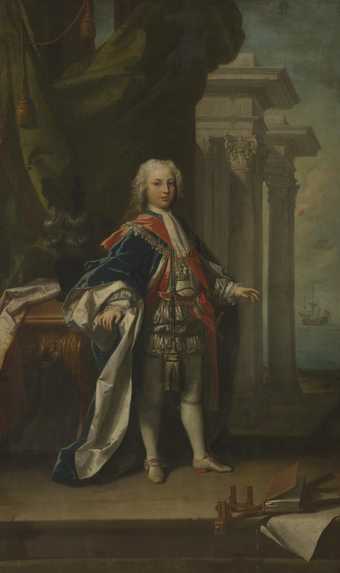
Not on display
- Artist
- Giacomo Amiconi 1682–1752
- Medium
- Oil paint on canvas
- Dimensions
- Support: 655 × 645 mm
frame: 730 × 720 × 72 mm - Collection
- Tate
- Acquisition
- Purchased 1971
- Reference
- T01299
Summary
This is a preliminary oil sketch for one of the four large canvases by Amiconi which still decorate the lower part of the Hall at Moor Park, Hertfordshire. Together they illustrate the story from Greek mythology of Jupiter and Io, told in Ovid's Metamorphoses, Book 1. Io was seduced by the god Jupiter who later turned her into a white heifer to hide his infidelity from his wife, Juno. Not deceived, Juno requested the heifer as a present and charged Argus, who had one hundred watchful eyes, to guard her. Unable to bear Io's suffering, Jupiter ordered his son, Mercury, to slay Argus, who did so after disguising himself as a herdsman and charming Argus to sleep with music from his pipe. Amiconi's fourth canvas completes the narrative, showing Juno receiving Argus's severed head, the eyes from which she took and placed in the tails of her peacocks. Mercury about to Slay Argus is the third canvas. The sketch is similar to the finished version in almost every respect, but omits its arched top as well as the figure of Jupiter, with his symbolic eagle, surveying the scene from a cloud.
The Venetian artist Amiconi (also known as Jacopo Amigoni) arrived in England from Munich in 1729 and remained there for ten years, establishing himself as a mythological decorative painter and also as a portraitist. In 1730-2 he was commissioned to redecorate Moor Park by Benjamin Styles, a wealthy city financier, who made a great fortune in the South Sea Company. Styles had purchased the house in 1720 and had commissioned the Venetian architect Giacomo Leoni (1686-1746) and Sir James Thornhill (1675 or 6-1734) to remodel it architecturally. Thornhill was also responsible for the splendid interiors, in particular the Hall, but Styles disputed his £1,300 bill which led to two lawsuits, in 1728 and 1730, which Styles lost. The almost immediate employment of Italian decorators to transform Thornhill's work presumably was a deliberate act of retaliation.
Amiconi worked at Moor Park in collaboration with the Venetian artist, Francesco Sleter (1685-1775), and Gaetano Brunetti (d.1758), an Italian quadraturista, or painter of illusionist architecture. He had worked with Brunetti before in 1730-1, on the staircase at Tankerville House, St James's Square, London, his first project in England where Brunetti had taken the lead role. At Moor Park, Sleter is thought to have acted as master painter. He signed the painted staircase in 1732 and was responsible for the Saloon (although Amiconi probably contributed), where his Four Seasons are surrounded by Brunetti's elaborate, feigned ornament. Amiconi's fine Jupiter and Io series in the Hall is entirely his own work, the canvases replacing ones by Thornhill which had been of the same size and shape but which had treated a more ponderous, Augustan theme - scenes of Heroic Virtue 'taken from several stories of the Antients, Greeks & Latins & Britons' (Vertue Notebooks III, Walpole Society, vol.22, 1933-4, p.35). Amiconi's works are lighter, both in subject matter and manner as well as palette, and are characteristic of the work produced by the group of Venetian decorative artists currently fashionable in England. The rich relief ornament that still surrounds them survives from Thornhill's earlier scheme.
A sketch for the second canvas of the series, Argus Lulled to Sleep, survives (Staatliche Kunstsammlungen, Dresden) as does a small-scale mythological picture treating the same subject (Seattle Art Museum). The latter was probably not connected to Moor Park but was painted in England, for Amiconi's great friend, the celebrated castrato singer Carlo Broschi, called Farinelli (1705-82).
Further reading
Edward Croft-Murray, Decorative Painting in England 1537-1837, II, 1970, pp.277-9.
Elizabeth Einberg and Judy Egerton, The Age of Hogarth: British Painters born 1675-1709, Tate Gallery Catalogues of the Permanent Collections, II, 1988, pp.13-15.
Annalisa Scarpa Sonino, Jacopo Amigoni, Soncino, 1994, pp.30-1 and no.13, p.86.
Tabitha Barber
April 2001
Does this text contain inaccurate information or language that you feel we should improve or change? We would like to hear from you.
Display caption
This is a sketch for one of four decorative canvases painted for the Hall at Moor Park, Hertfordshire. The series illustrates the story of Jupiter and Io from Ovid’s Metamorphoses. Jupiter seduced Io and changed her into a white heifer – on the left here – to hide his infidelity. But Jupiter’s wife Juno discovered the truth and sent Mercury, on the right, to kill her. Giacomo Amiconi was born in Venice and he worked in London from 1729-39. He became a successful portrait painter and a scenery designer at Covent Garden Theatre.
Gallery label, May 2007
Does this text contain inaccurate information or language that you feel we should improve or change? We would like to hear from you.
Catalogue entry
T01299 Mercury about to Slay Argus 1730–32
Oil on canvas 655×645 (25 7/8×25 1/8)
Purchased (Grant-in-Aid) 1971
PROVENANCE ...; private collector near Freiburg im Breisgau c. 1964, by whom sold to a German dealer and by him to the Galerie Munsterberg 8, Basle; sold by them, Sotheby's 24 March 1971 (53, repr.) bt Colnaghi for the Tate Gallery
EXHIBITED English Baroque Sketches, Marble Hill, Twickenham 1974 (76, repr.); Pittura inglese 1660–1840, Palazzo Reale, Milan 1975 (57, repr.)
LITERATURE Vertue III, pp. 35, 46, 63; F.J.B. Watson, ‘English Villas and Venetian Decorators’, RIBA Journal, LXI, 1954, p.XX; Christopher Hussey, English Country Houses: Early Georgian, 1955, p.43; English Taste in the Eighteenth Century, exh. cat., RA 1955–6, pp. 26–7, no. 6; Croft-Murray 1962, pp. 76–7, 272, 1970, pp. 18–19, 165; T.P. Hudson, ‘Moor Park, Leoni and Sir James Thornhill’, Burlington Magazine, CXIII, 1971, pp. 657–61; A. Baird, ‘Jacopo Amigoni in England’, Burlington Magazine, CXV, 1973, p. 734, fig. 41
This sketch is for one of the four large decorative paintings by Amiconi at Moor Park near Rickmansworth, Herts., some fifteen miles north-west of London. In the finished picture (repr. in col., Waterhouse 1981, p.19) Jupiter, accompanied by putti and an eagle, is seen reclining on a cloud overhead, surveying the scene. Argus holds a staff in his right hand and the two cowherds behind are more sharply defined. The finished picture is an upright with a shaped top and it is clear that the Tate Gallery's sketch was originally also an upright, the original paint continuing over the turn-over at the top and being cut off at the present edge; there are however no traces of Jupiter and his companions in the corresponding area of the sky in the sketch, part of which has been retained. The original size of of no. 1 is suggested by a companion sketch for ‘Argus Lulled to Sleep’, approx. 760×635 (30×25), in the Gemäldegalerie, Dresden, catalogued as by Pellegrini (see Baird, p. 734, fig. 42).
Moor Park was bought and rebuilt in 1720 by the city magnate Benjamin Styles, the chief architect being Sir James Thornhill who also decorated the hall with eight large inset canvases ‘representing 8 heroic Virtues taken from several stories of the Antients, Greeks & Latins & Britons’ (Vertue, p.35) as well as the ceiling. There was, however, a dispute over part of Thornhill's bill, leading to two lawsuits in 1728 and 1730, and in 1732 Vertue recorded that ‘Mr Styles of More Park has had painted by Amiconi (I hear) 7 or 8 stories to place in his hall in lieu of those Sr. James Thornhill did - & no doubt intended as a mortification to him’ (p. 63).
Amiconi in fact painted only four pictures, those decorating the main walls of the hall below the gallery; the four canvases of gods above are probably by Francesco Sleter (1685–1775). They illustrate the subject of Jupiter and Io from Ovid's Metamorphoses. Jupiter, enamoured of the nymph Io, changed her into a heifer to protect her from the jealousy of Juno who, suspicious of what was going on, asked for the heifer and handed her over to ‘hundred-eyed’ Argus for safe-keeping. Jupiter asked Mercury to kill Argus, which he did after first lulling him to sleep. Juno then took Argus's eyes and used them to decorate the tail of her peacock. Io was eventually restored to human shape and gave birth to Epaphus. The four pictures show ‘Jupiter and Io’, ‘Argus Lulled to Sleep by the Flute of Mercury’, ‘Mercury about to Slay Argus’ and ‘Juno Receiving the Head of Argus from Mercury’.
A set of four small but finished pictures by Amiconi, each approx. 775×650 (30 5/8×25 1/16), includes two variants of the Moor Park pictures: ‘Argus Lulled to Sleep’, in the Seattle Art Museum, and ‘Jupiter and Io’, in the Mayer sale, Lepke, Berlin, 7–9 October 1913, lots 432–4 with the two other pictures, showing a ‘Dancing Bacchante’ and a ‘Sleeping Bacchante’. These seem to have belonged to Amiconi's friend the castrato Farinelli (see Jacob Simon in Marble Hill 1974, exh. cat.).
The Tate Gallery also owns a sketch for one of the earlier Moor Park decorations. This is by Antonio Verrio (T00916) and is for the ceiling of the saloon, probably painted for the Duke of Monmouth between 1670 and 1685 but preserved when the house was rebuilt by Thornhill (see Croft-Murray 1962, p. 239).
Published in:
Elizabeth Einberg and Judy Egerton, The Age of Hogarth: British Painters Born 1675-1709, Tate Gallery Collections, II, London 1988
Explore
- emotions, concepts and ideas(16,416)
-
- universal concepts(6,387)
-
- transformation(186)
- classical(198)
- actions: expressive(2,622)
-
- attacking(165)
- running(125)
- sleeping(315)
- man(10,453)
- classical myths: gods and heroes(606)
-
- Argus(4)
- Io(1)
- Mercury / Hermes(30)
You might like
-
Sir James Thornhill The Apotheosis of Romulus: Sketch for a Ceiling Decoration, Possibly for Hewell Grange, Worcestershire
c.1710 -
William Hogarth Satan, Sin and Death (A Scene from Milton’s ‘Paradise Lost’)
c.1735–40 -
Attributed to John Butts Poachers: View in the Dargle
c.1760 -
Philip Mercier The Schutz Family and their Friends on a Terrace
1725 -
Richard Wilson Meleager and Atalanta
c.1770 -
Francesco Zuccarelli A Landscape with the Story of Cadmus Killing the Dragon
exhibited 1765 -
Benjamin Ferrers Three Ladies of the Leman Family and their Dogs on a Terrace
1728 -
George Lambert, Francis Hayman View of Copped Hall in Essex, from the Park
1746 -
Giacomo Amiconi Portrait of a Man
date not known -
Agostino Brunias Dancing Scene in the Caribbean
1764–96 -
Giacomo Amiconi Frederick, Prince of Wales
1735 -
Giacomo Amiconi William, Duke of Cumberland
1735

